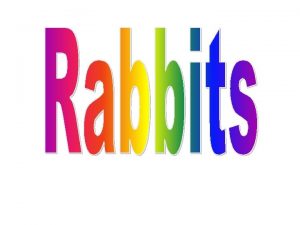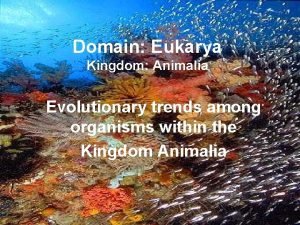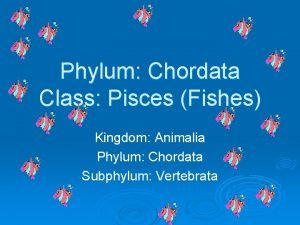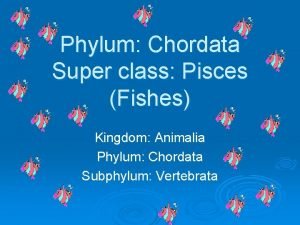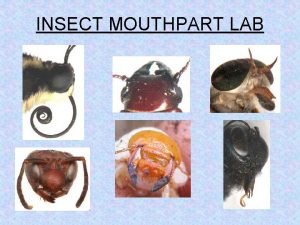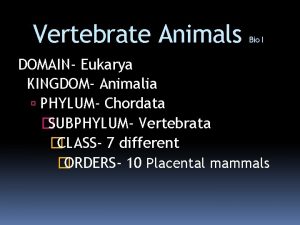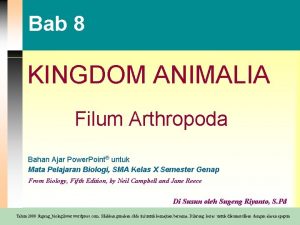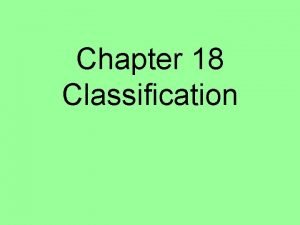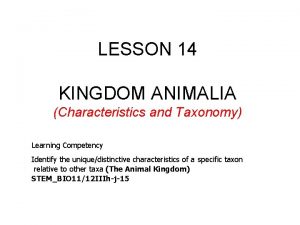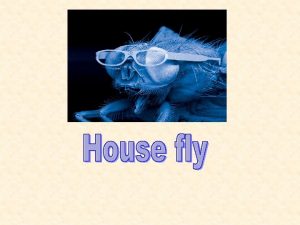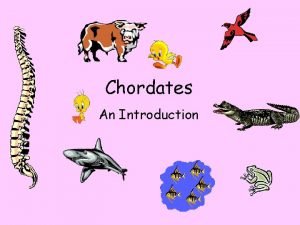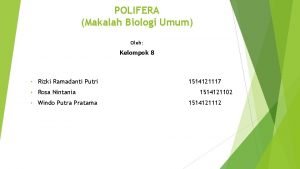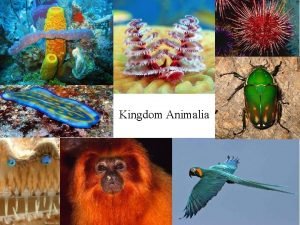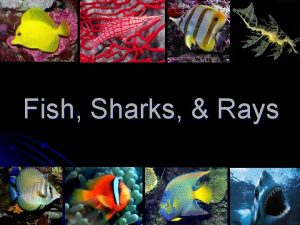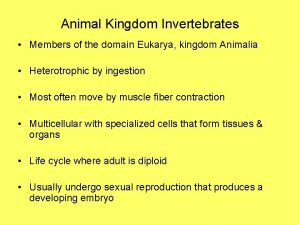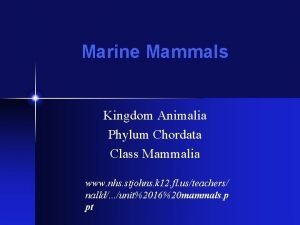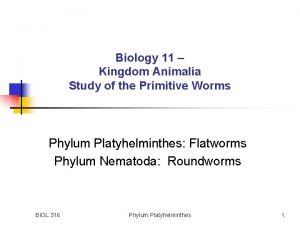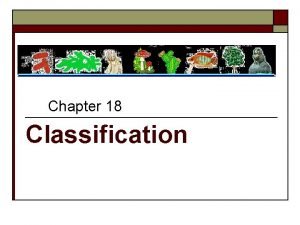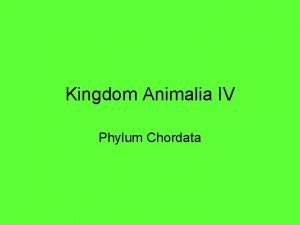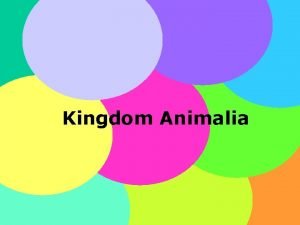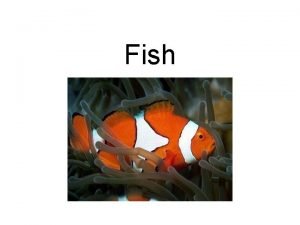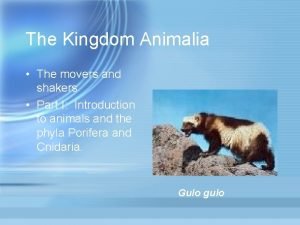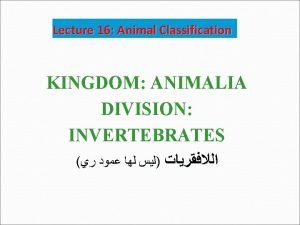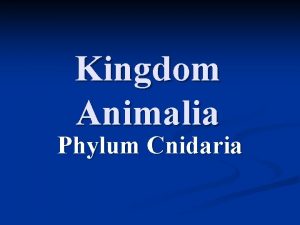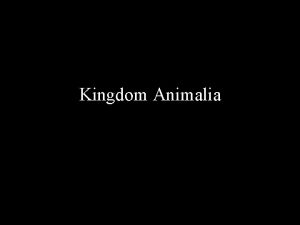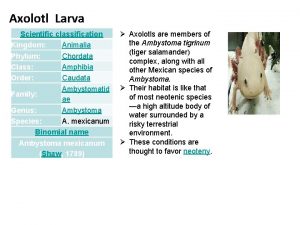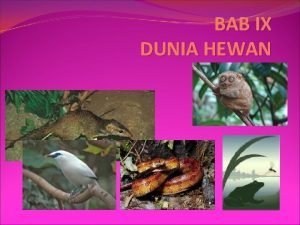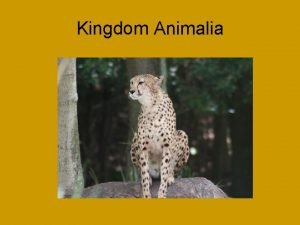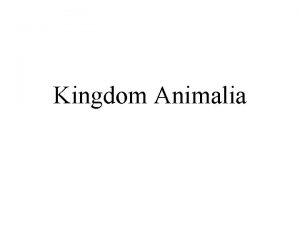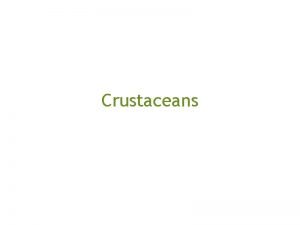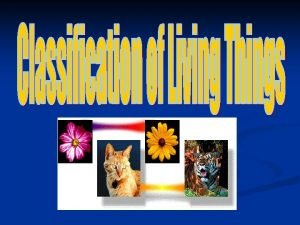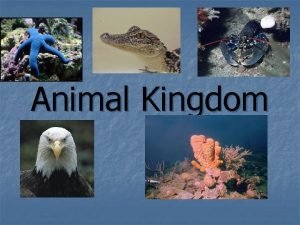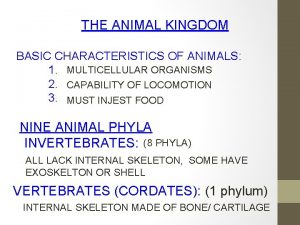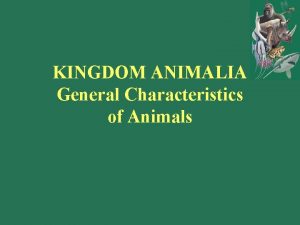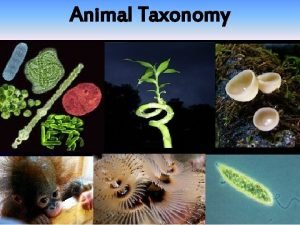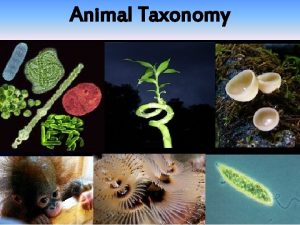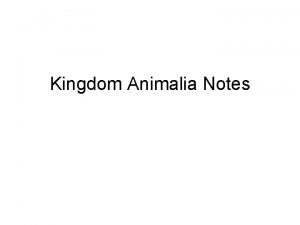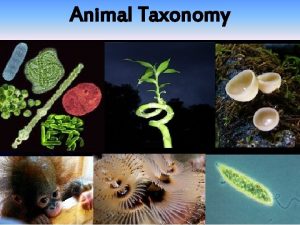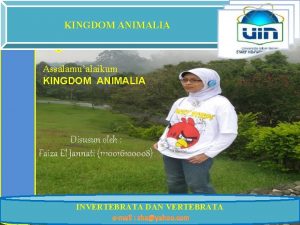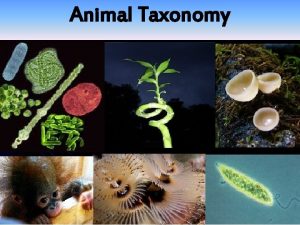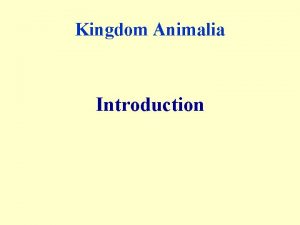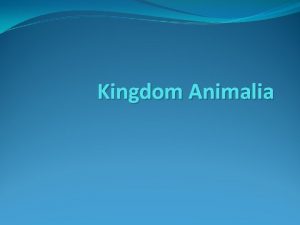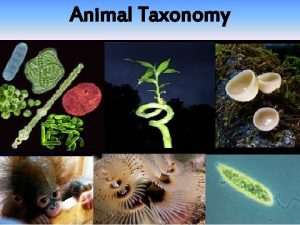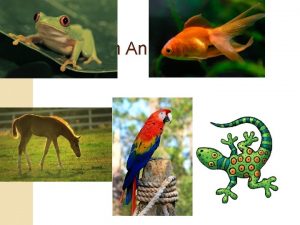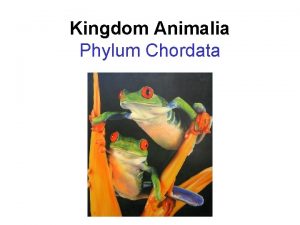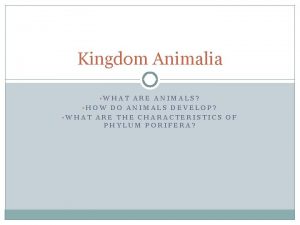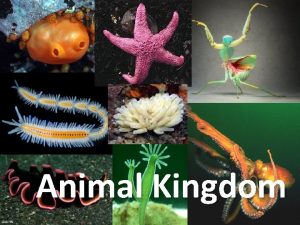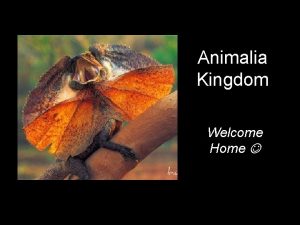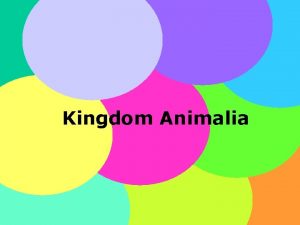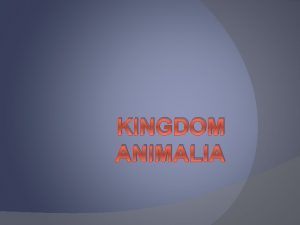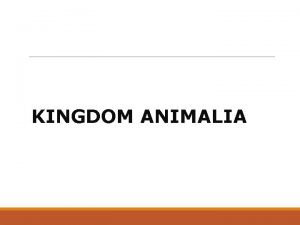The Animals Kingdom Animalia Kingdom Animalia Animals What


















































- Slides: 50

The Animals: Kingdom Animalia

Kingdom Animalia (Animals) • What is an Animal?

Zoology- The study of Animals

General Characteristics of Animals 1. Animals are multicellular and eukaryotic. 2. Animals consume organic materials and digest it and are termed heterotrophs.

3. There are two main types of animals, vertebrates and invertebrates. A vertebrate has a backbone while an invertebrate has no backbone (no bones at all usually!!!)

4. Most animals are motile at some time in their lives though some simple forms are attached to a substrate (sessile).

5. Many animals have tissues specialized for specific functions (nerve tissue, muscle).

6. Many lower forms have simple asexual and sexual reproduction while higher forms reproduce sexually exclusively.

Classifying Animal Phyla 1. Body organization (cells organized into tissues, organs and organ systems)

2. Number of germ layers (embryonic tissues from which more specialized tissues develop) Layers : 1. Endoderm is inner layer of cells. It gives rise to digestive tract 2. Ectoderm is the outer layer of cells. It gives rise to the skin and to the nervous system. 3. Mesoderm is the middle layer of cells. It gives rise to the circulatory, skeletal and reproductive systems.

3. Body symmetry refers to the body being cut in two halves having matching shapes. • Animals with no symmetry are asymmetrical (sponges). • Radial symmetry is based around the point in the central axis of a tube (anemone). • Animals like humans have two equal halves, bilateral symmetry. The sides of the body have special names: dorsal, ventral, anterior, posterior, medial, lateral, proximal, distal.

Asymmetry

Spatial Relationships (bilateral symmetry) • • • Dorsal - upper side or back Ventral - lower side or belly Anterior - front region or head Posterior - hind , rear , or tail end Lateral - side • Note : Animals with bilateral symmetry have a true head. It shows cephalization which refers to a concentration of nerve tissue and receptors at the anterior end of the animal’s body.

Identify the spatial relationships

4. A complete or incomplete digestive tract • A complete digestive tract has one- way flow, and two openings: the mouth where food enters and the anus where wastes leave. Ex: Humans, cats, worm, etc. • An incomplete digestive tract has twoway flow, and one opening in which food enters and wastes leave. Ex: Flatworm, Hydra

Complete and Incomplete digestion

5. Development (or not) of an internal cavity called a coelom. A coelom is a fluid filled cavity surrounded by the mesoderm — a layer of epithelial cells that line the body cavity and gut ; (found in all vertebrates and many invertebrates).

Importance of a body cavity • 1. Provides space where internal organs can be suspended without being affected by muscle pressure and body movement • 2. Provide space for internal organs to develop and expand • 3. Contain fluids which may assist in internal transport of nutrients , and gas exchange ; contains a peritoneum which is a covering membrane that lines the body cavity and covers the internal organs. Less complex vertebrates have a pseudocoelom, a fluid filled cavity of variable shape which has no peritoneum.

Coelomates • Animals without a coelom are called acoelomates. • Animals with a fluidfilled cavity and no peritoneum are pseudocoelomates. • Animals with a fluidfilled body cavity or coelom are called coelomates.

Invertebrate Phyla: 1. 2. 3. 4. 5. 6. 7. 8. Porifera Cnideria Platyhelminthes Nematoda Annelida Mullusca Arthropoda Echinodermata

Porifera • The sponges – – Asymmetrical Acoelomate Filter feeders Asexual reproduction (budding) – Sexual reproduction (gametes- external fertilization) http: //study. com/academy/lesson/phyl um-porifera-definition-characteristicsexamples. html

Cnidaria - Jellyfish, Sea Anenomes, Coral and Hydra - Greek word "cnidos, " which means stinging nettle. - Radial symmetry - Filter Feeders - Asexual and Sexual Reproduction - http: //shapeoflife. org/video/cni darians-life-move

Platyhelminthes • The flatworms. • Ex: planarians, tapeworms, blood flukes • Bilateral symmetry • Two-way digestion • Some parasitic • Asexual and sexual reproduction with internal fert. • http: //study. com/academy/les son/platyhelminthesdefinition-characteristicsexamples. html

Nematoda • The round worms (ex: hookworm, pinworm) • Pseudocoelomates • Bilateral symmetry • One-way digestion • Many parasitic • Sexual reproduction (internal fertilization) https: //www. youtube. com/watc h? v=d. YPF 5 dm. T__o

Annelida • Segmented worms • Earthworms and leeches • Bilateral symmetry • One-way digestion • Coelomates • Sexual reproduction (internal fert) http: //study. com/academy/le sson/phylum-annelidacharacteristics-classesexamples. html

Mollusca • Snails, slugs, clams, mussels, octopus, squid • Bilateral symmetry • Coelomate • One-way digestion • Sexual reproduction

Echinodermata • • • Pentamorous Radial Symmetry One way digestion Mostly sexual reproduction (external fert) Sea stars, Sand dollars, Sea Urchins, Sea Cucumbers https: //study. com/academy/lesson/phylum-echinodermatadefinition-characteristics-examples. html#transcript. Header

Arthropoda • Ex: Insects, Spiders, Crab, lobster, Butterflies • Bilateral symmetry • Mostly Sexual reproduction (internal and external fertilization) • One-way digestion • Exoskeleton • Jointed appendages • Developed nervous system

Developmental trends — Invertebrates: • 1. We go from simple to complex as organisms evolve. • 2. Simplest organisms have asymmetry. As complexity increases, we go to radial and finally bilateral symmetry. • 3. Organisms go from having no cavity to a false cavity to a true body cavity. • 4. Simpler organisms may reproduce sexually and asexually. As complexity increases, organisms reproduce only sexually.

Developmental trends — Invertebrates • 5. Simpler ones have two tissue layers, more complex have three tissue layers. • 6. Sessile to motile. • 7. Simpler ones have no tissue, no systems. As complexity increases, the more systems an organism has (both in # and complexity). • Note : Many invertebrates are hermaphrodites (contain male and female parts) , but rarely can they self-fertilize.

Vertebrates Brainstorm: Can you guess all six types animals that make up the vertebrates? What do they have in common?

Vertebrates

Common characteristics for all vertebrates would be: • • • Presence of a notochord (backbone) A dorsal nerve cord Gill slits Endoskeleton , appendages , and skin Closed circulatory system with an increasingly complex heart structure • Increased cephalization and increased size and complexity of the cerebrum • Presence of a coelom to hold increasingly complex systems for digestion, excretion, reproduction, circulation and respiration

The vertebrate classes: 1. Agnatha (Jawless fish) - Includes the Lamprey and Hagfish. - Cartilagonous - Two chambered heart! - No operculum

2. Chondricthyes • • Skeleton made of Cartilage. Includes Sharks, Skates and Rays Two Chambered heart No Operculum

3. Osteichthyes • Boney fish • Includes Cod, Salmon, Trout • Two chambered heart • Gill slits covered by operculum.

4. Amphibia • Includes frogs and salamanders. • Have a 3 chambered heart. • Exchange gas through gills, skin and lungs!

5. Reptilia • Includes snakes and turtles • Three chambered heart with incomplete septum for fourth. • Have lungs with a moderate surface area • Internal fertilization, external development!

6. Aves • Includes all birds. • Lungs have the highest surface area. • 4 chambered heart • Internal fertilization, external development

7. Mammals • Includes humans, whales • 4 chambered heart • Internal fert. /internal development


Evolutionary developmental Trends - Vertebrates • 1. Adaptations leading from total dependence on water to survival on land (evolutionary trend from external fertilization towards internal fertilization). • 2. Development of a more complex heart structure (from a two chambered to three chambered to four chambered heart). • 3. Increase in cephalization (concentration of nerve tissue in anterior region). • 4. Increase in size and complexity of the cerebrum (anterior part of brain). • 5. Body system functions increase in complexity with evolution.

Which animal is the most successful (most widespread and diverse)? • Brainstorm • Why?


Success (Phylum Arthropoda) is due to: 1. rigid, jointed external skeleton or exoskeleton (for protection). 2. well-defined head with jointed appendages 3. specialized body segments fused into distinct regions such as head, thorax and abdomen. 4. well-developed nervous system. 5. different structures and functions for obtaining nourishment

Kingdom Animalia Representative Life Cycle- The Frog

Example of the Frog Life Cycle (as an example of an animal): (See Figure 6. 26, p. 193). A. A frog will undergo external fertilization; (the sperm and egg meet outside the bodies of both parents). Fertilization of frog eggs is external. During mating, the male frog mounts a female frog and helps to squeeze the eggs from the female’s body. The male will then release sperm on top of the eggs. Once an egg has been fertilized, development begins immediately.

B. The larva of the frog or tadpole will emerge from the egg in a few days. C. The young tadpole has a tail for swimming and gills for respiration. This tadpole stage of a frog may last a few months up to two years, depending on the frog species. D and E. Tadpoles eat plants and algae. The tadpole will undergo a complete change in form or metamorphosis; (older tadpoles start to develop legs). This metamorphosis usually takes one or two months and the young frog will have well-developed legs, but no tail. It eventually becomes an adult frog fully adapted for life on the land.


 Youtube egypt
Youtube egypt Old kingdom middle kingdom new kingdom
Old kingdom middle kingdom new kingdom Old kingdom middle kingdom new kingdom
Old kingdom middle kingdom new kingdom Old kingdom middle kingdom new kingdom
Old kingdom middle kingdom new kingdom Family leporidae kingdom
Family leporidae kingdom Domain eukarya kingdom animalia
Domain eukarya kingdom animalia Cladogram animal kingdom
Cladogram animal kingdom Phylum pisces
Phylum pisces Pisces kingdom animalia
Pisces kingdom animalia Animalia kingdom
Animalia kingdom Domain eukarya kingdom animalia
Domain eukarya kingdom animalia Kingdom animalia ppt
Kingdom animalia ppt Kingdom animalia contains 350 000 species of what
Kingdom animalia contains 350 000 species of what The mcgraw-hill
The mcgraw-hill Diptera
Diptera Animalia kingdom chordates and vertebrates
Animalia kingdom chordates and vertebrates Manfaat calcarea
Manfaat calcarea Kingdom monera protista fungi plantae animalia
Kingdom monera protista fungi plantae animalia 3 germinal layers
3 germinal layers Shark skates and rays are also called
Shark skates and rays are also called Plantae prokaryotic or eukaryotic
Plantae prokaryotic or eukaryotic Domain eukarya kingdom animalia
Domain eukarya kingdom animalia Seal phylum
Seal phylum Cladogram of 6 kingdoms
Cladogram of 6 kingdoms Characteristics of platyhelminthes
Characteristics of platyhelminthes Animalia domain
Animalia domain What are the rules for writing scientific names
What are the rules for writing scientific names What are chordata
What are chordata Hewan dengan ciri ciri telapak kaki berjari ganjil
Hewan dengan ciri ciri telapak kaki berjari ganjil Clownfish class
Clownfish class Nine phyla of kingdom animalia
Nine phyla of kingdom animalia Karakteristik animalia
Karakteristik animalia Kingdom animalia phylum cnidaria
Kingdom animalia phylum cnidaria Cladogram of kingdom animalia
Cladogram of kingdom animalia Phylum cnidaria polyp
Phylum cnidaria polyp Axolotl higher classification
Axolotl higher classification Insect order classification
Insect order classification Ciri umum kingdom animalia adalah
Ciri umum kingdom animalia adalah Multicellular characteristics
Multicellular characteristics Animalia characteristics
Animalia characteristics Kingdom animalia phylum arthropoda
Kingdom animalia phylum arthropoda Kingdom animalia cell structure
Kingdom animalia cell structure Animals that eat both plants and animals
Animals that eat both plants and animals Https//a-z-animals.com/animals
Https//a-z-animals.com/animals Consumer decomposer producer
Consumer decomposer producer Parasitic food chain
Parasitic food chain No bones animal
No bones animal Characteristics of animals kingdom
Characteristics of animals kingdom Protista mobility
Protista mobility Kingdom plantae characteristics
Kingdom plantae characteristics Domain eukarya kingdom plantae
Domain eukarya kingdom plantae




